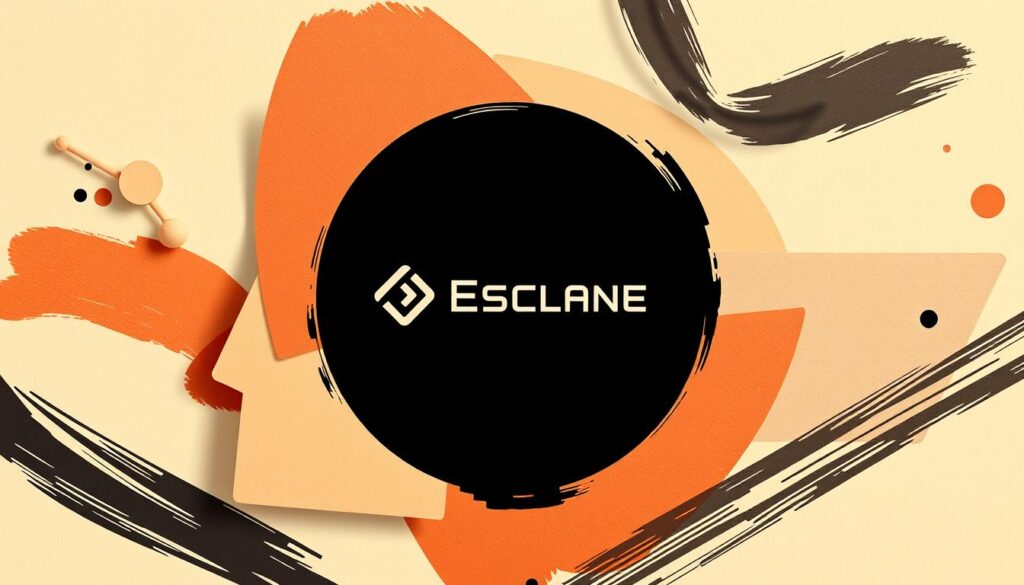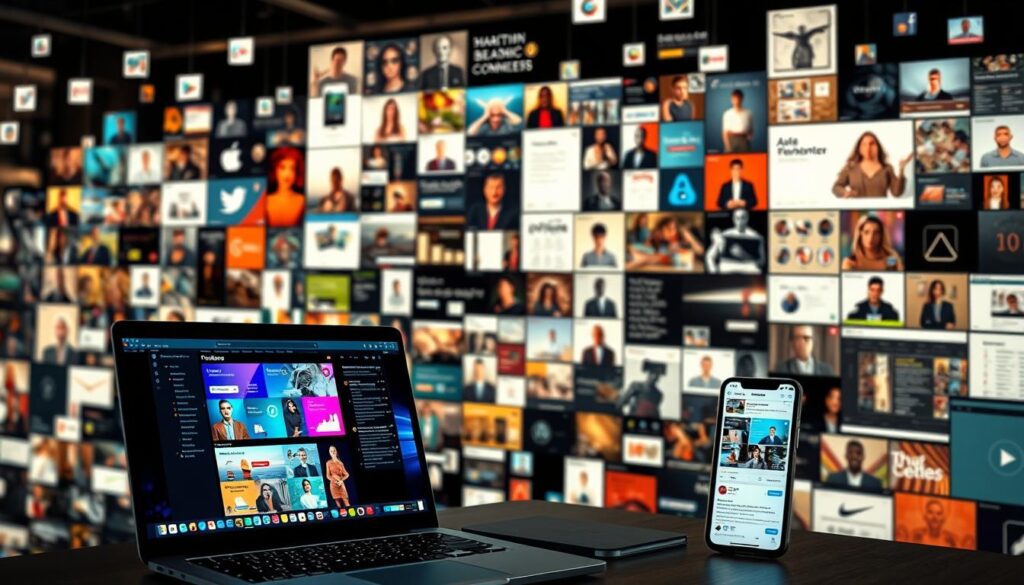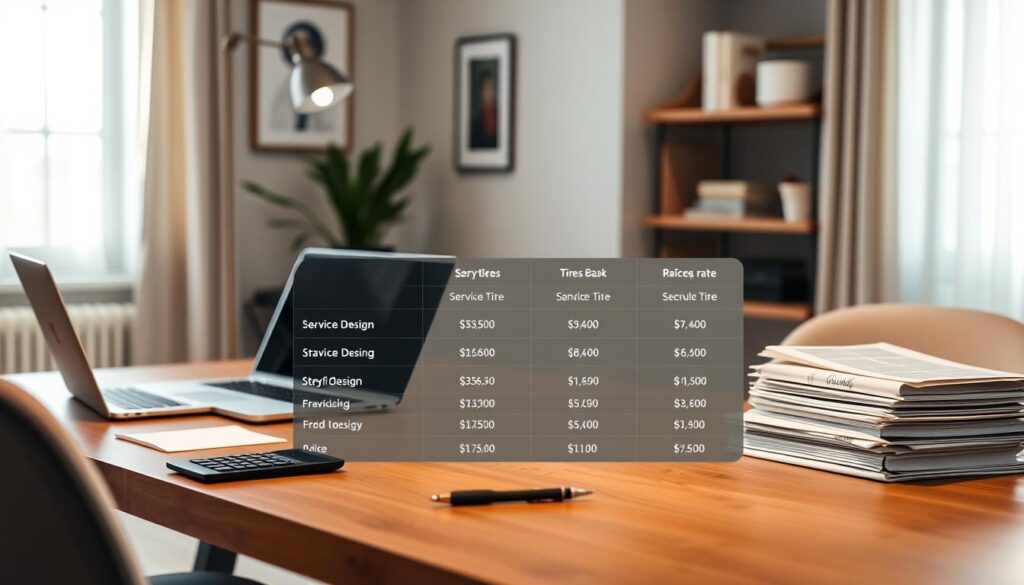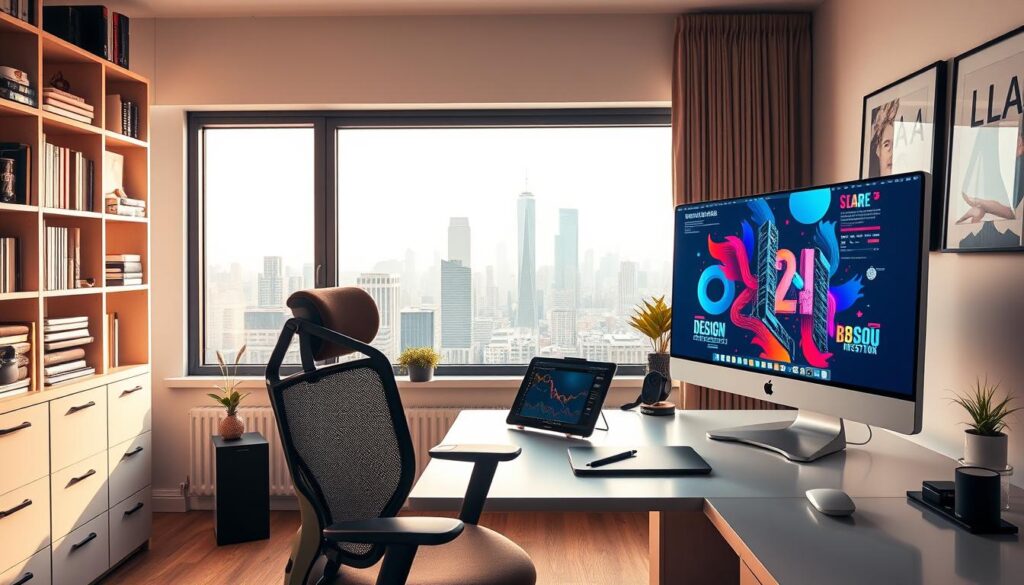“The design is not just what it looks like and feels like. The design is how it works.” — Steve Jobs
In today’s fast-paced digital world, graphic design plays a pivotal role in shaping brand identities and driving marketing strategies. For aspiring graphic designers, the freelance world offers a wealth of opportunities to turn creativity into a successful career. This guide serves as your comprehensive roadmap to launching and growing a thriving freelance graphic design business.
As a freelance graphic designer, you’ll enjoy the freedom to choose projects that align with your passion and skills, blending artistic talent with business savvy. The demand for skilled designers is on the rise, making this an exciting time to enter the field. Whether you’re just starting out or looking to expand your client base, this article will equip you with the insights and strategies needed to succeed in this dynamic industry.
So, let’s dive in and explore how you can turn your design skills into a fulfilling and profitable freelance career.
Key Takeaways
- Understanding the importance of graphic design in modern marketing and branding.
- Exploring the unique opportunities available to freelance graphic designers.
- Learning how to blend creativity with business acumen for a successful career.
- Discovering the benefits of pursuing a freelance graphic design career.
Understanding the Freelance Graphic Design Landscape
Freelance graphic design is more than just creating visually appealing work. It’s about solving problems and communicating ideas effectively. This field is constantly evolving, with new trends and technologies emerging regularly. As a freelance graphic designer, staying ahead of these trends is crucial for success.
Evolving Industry Trends
One major trend in freelance graphic design is the shift towards digital-first designs. Companies are focusing more on online presence, which means higher demand for website designs, social media graphics, and digital ads. Another key trend is the use of motion graphics and video content, which has become essential for engaging audiences on platforms like Instagram and TikTok.
Opportunities in the United States
The United States offers a thriving market for freelance graphic designers. According to PayScale, graphic designers in the U.S. earn an average salary of $53,380 per year, with experienced freelancers commanding up to $150 per hour. This reflects the high demand for skilled designers who can deliver creative solutions that align with business goals.
Iconic designs like McDonald’s golden arches and movie posters show the power of graphic design in shaping brand identities. These examples highlight how effective design can make a company recognizable and memorable. By understanding these trends and opportunities, freelance graphic designers can position themselves to thrive in this competitive landscape.
Defining Your Niche and Creative Vision
Your niche is the foundation of your freelance graphic design business. It’s what sets you apart in a crowded market and helps you attract the right clients. By focusing on a specific area, you can showcase your expertise and deliver tailored solutions that meet your clients’ needs.
Finding Your Unique Style
Developing a unique style is a process that combines skill, creativity, and research. Start by identifying what inspires you and how you can translate that into your work. Whether it’s minimalistic designs or vibrant visuals, your style should reflect your artistic voice while resonating with your target audience.
- Refine your skills in design principles and software to create polished, professional work.
- Gather information about your audience to align your designs with their preferences and expectations.
- Experiment with different techniques to find what makes your art stand out in the industry.
Remember, your personal style is a key factor in your professional success. By blending your creative vision with strategic insights, you can build a portfolio that attracts clients and grows your business. A well-defined niche not only helps you stand out but also allows you to charge premium rates for specialized services.

Essential Graphic Design Skills and Principles
Mastering the fundamentals of graphic design is crucial for any aspiring designer. These skills form the backbone of creating compelling and effective visual content. Whether you’re working on a logo, a website, or an advertisement, understanding color theory, typography, and visual storytelling will help you communicate your message clearly and engage your audience.
Color Theory and Typography
Color and typography are powerful tools in a designer’s arsenal. Color theory helps you choose palettes that evoke the right emotions, while typography ensures your message is readable and visually appealing. For instance, bold fonts can convey confidence, while softer colors like blue can create a sense of trust. These elements work together to guide the viewer’s eye and enhance the overall impact of your design.
Visual Storytelling Techniques
Visual storytelling is about more than just images—it’s about connecting with your audience on an emotional level. By using imagery, composition, and hierarchy, you can lead the viewer’s eye through your design. This technique is especially effective in creating memorable campaigns that resonate long after the initial glance.
Refining these skills takes time and practice. Start by experimenting with different tools and programs to find what works best for you. Remember, the goal is to create designs that not only look great but also communicate your message effectively. By mastering these essential principles, you’ll be well-equipped to handle any design challenge that comes your way.
Crafting a Unique Brand Identity
Your brand identity is the heart of your freelance graphic design business. It’s what makes you stand out and attracts the right clients. A strong brand identity can boost recognition and help you build a loyal client base.
Developing a Memorable Logo
A great logo is more than just a pretty image. It’s the face of your brand and a key part of your identity. Let’s break down how to create one that sticks in people’s minds.
- Start with understanding: Take time to really get what your client wants and who they are.
- Brainstorm ideas: Sketch out different concepts until you find one that clicks.
- Refine your design: Keep it simple and make sure it looks good everywhere, from a business card to a billboard.
- Final touches: Make sure the colors and fonts align with the brand’s message.
Take Apple and Nike, for example. Their logos are simple yet powerful, making them easy to recognize. Apple’s sleek apple logo and Nike’s swoosh symbolize innovation and movement, respectively.
Combining your creativity with your experience leads to effective branding. The more you design, the better you get at creating logos that resonate. This experience helps you understand what works and what doesn’t, making your designs more impactful.

Investing time in your brand identity pays off. It helps you stand out, attracts the right clients, and builds a strong foundation for your career as a graphic designer. Remember, your brand is your story, so make it one worth telling.
Building a Professional Portfolio
A professional portfolio is the cornerstone of a successful freelance career. It’s more than just a collection of your work; it’s a showcase of your skills, creativity, and problem-solving abilities. A well-crafted portfolio helps potential clients understand your value and see how you can meet their needs.
When building your portfolio, focus on quality over quantity. Select projects that highlight your best work and demonstrate your range as an artist. Whether it’s a logo design, a website layout, or a branding campaign, each piece should tell a story of how you approached the challenge and delivered a solution. This balance of creative artistry and professional principles is key to attracting the right clients.
- Highlight your skills: Choose projects that showcase your expertise in areas like color theory, typography, and visual storytelling.
- Include case studies: Provide detailed descriptions of your design process, from concept to completion, to show your problem-solving skills.
- Keep it updated: As you gain experience and develop new skills, refresh your portfolio to reflect your growth.
Remember, your portfolio is a living document that evolves with your career. By continually refining it, you’ll stay competitive and attract clients who appreciate your talent and professionalism.

Setting Up Your Business Infrastructure
Building a successful freelance graphic design business requires more than just creative skills. Setting up the right infrastructure is essential to streamline operations and ensure long-term growth. This section will guide you through choosing the right business model and managing finances effectively.
Choosing the Right Business Model
Freelance graphic designers can operate under various business models. The most common include:
- Sole Proprietorship: Simple to set up and ideal for independent contractors.
- LLC (Limited Liability Company): Offers liability protection and tax benefits.
- Partnership: Suitable if you’re collaborating with others.
Each model has its pros and cons. For example, an LLC provides legal protection but involves more paperwork, while a sole proprietorship is easier to establish but offers no liability protection.
Managing Finances and Legal Considerations
Effective financial management is crucial. Consider using budgeting tools like Mint or YouNeedABudget (YNAB) to track expenses. Invoicing software such as FreshBooks can streamline client billing and payment tracking.
Legally, register your business to obtain necessary licenses. Consult a tax professional to understand your obligations, including self-employment taxes. Drafting contracts is vital to protect both you and your clients, outlining project scope, payment terms, and intellectual property rights.

A well-structured business infrastructure allows you to focus on your creative work while maintaining professional relationships with clients. By combining artistic talent with robust business practices, you’ll build a sustainable and thriving freelance career.
Establishing Effective Client Communication
Clear communication is the backbone of any successful freelance graphic design business. It’s not just about exchanging ideas but ensuring both parties are on the same page. Effective communication helps build trust, reduces misunderstandings, and ensures projects are completed to everyone’s satisfaction.
A well-organized portfolio can be a powerful tool in client discussions. It showcases your skills and experience, helping clients understand your approach and how you can meet their needs. Presenting your work in a professional manner, using high-quality images and clear descriptions, makes it easier for clients to visualize the final result.
Active listening and empathy are crucial in building strong client relationships. By understanding their vision and expectations, you can tailor your approach to deliver work that resonates with them. Using simple, jargon-free language ensures that your message is clear and easily understood.
Visual aids like color palettes or design examples can help communicate complex ideas effectively. They provide a common reference point, making it easier for clients to provide feedback and for you to refine your work. Regular updates and proactive communication about potential challenges can enhance trust and lead to smoother project execution.

Friendliness and approachability go a long way in making clients feel comfortable sharing their thoughts. Encouraging open dialogue and being responsive to their inquiries can significantly improve client satisfaction. By focusing on their needs and delivering solutions that exceed expectations, you can build long-term relationships and a loyal client base.
Navigating the Transition to Freelance Work
Moving from a traditional job to freelance work can be both exciting and intimidating. Many designers find it challenging to leave the stability of a full-time position behind. However, with the right strategies, this transition can lead to a fulfilling career.
Overcoming Initial Challenges
One of the biggest hurdles is dealing with irregular income. To manage this, financial planning is key. Setting aside at least six months of living expenses can provide a safety net during slow periods. Creating a budget that includes business expenses like software and marketing costs is also essential.
Another challenge is finding consistent clients. Building a strong online presence through a professional portfolio and social media can help attract projects. Regularly posting work on platforms like Instagram and LinkedIn can engage potential clients and showcase your skills.
Adapting creative ideas into marketable services is crucial. For example, offering logo design or branding packages can appeal to businesses looking for a cohesive visual identity. This approach helps in positioning yourself as a valuable resource for clients.
Staying motivated is important during this transition. Believing in your abilities and building a support network of fellow freelancers can make a big difference. Remember, every successful freelancer started somewhere, and your unique perspective is an asset.

With persistence and the right strategies, you can navigate the transition smoothly and build a thriving freelance career. Keep learning, stay adaptable, and always showcase your creativity to attract clients and grow your business.
Leveraging Online Marketing and Networking
In today’s digital age, online marketing and networking are essential tools for freelance graphic designers. These strategies help you reach a broader audience, build your brand, and connect with potential clients. By leveraging these tools effectively, you can position yourself as a skilled designer and grow your business.
Optimizing Your Social Media Presence
Social media platforms like Instagram and Pinterest are perfect for showcasing your portfolio. Start by creating profiles that reflect your brand. Use high-quality images and consistent branding to make your work stand out. Engage with your audience by posting regularly and responding to comments. Sharing behind-the-scenes content can also help build a connection with potential clients.
For example, Instagram’s features like Stories and Reels allow you to share quick updates or time-lapse videos of your design process. This not only keeps your audience engaged but also demonstrates your expertise. Additionally, using relevant hashtags can increase your visibility and attract more followers.
Engaging on LinkedIn and Design Communities
LinkedIn is a powerful tool for professional networking. Create a detailed profile highlighting your skills and experience. Joining design communities and groups can help you connect with other professionals and potential clients. Participate in discussions, share your insights, and provide value to others.
Platforms like Dribbble and Behance are also great for showcasing your work. These communities are filled with designers and potential clients looking for fresh talent. By actively engaging and sharing your portfolio, you can increase your chances of landing new projects.

Remember, networking is about building relationships. By being active and supportive in these communities, you can establish yourself as a knowledgeable and reliable designer. This not only helps in finding job opportunities but also enhances your overall brand visibility.
Pricing Your Services Competitively
Setting the right price for your services is a critical step in attracting clients and growing your freelance graphic design business. Your pricing strategy should reflect your experience, the value you bring, and industry standards. As a designer, understanding what clients expect and how to position yourself competitively is key to success.
Several factors influence competitive pricing in freelance design. These include your experience, the complexity of the job, and the time required to complete it. For instance, a designer with more experience can charge premium rates, often between $75 to $150 per hour, depending on the project’s scope. Industry benchmarks show that project-based pricing for a complete brand identity can range from $5,000 to $10,000, while retainer-based models can bring in $2,000 to $5,000 monthly.
Balancing quality and cost is essential to attract the right clients. While lower prices might appeal to some, they may undervalue your expertise. Instead, focus on showcasing the value your designs bring. For example, value-based pricing allows you to charge 10-20% of the projected value your work adds to the client’s business. This approach highlights your contribution and justifies higher rates.
Negotiating prices confidently starts with clear communication. Be transparent about your process and the benefits clients gain. Emphasize your experience and portfolio to demonstrate your worth. Regularly reviewing and adjusting your rates ensures they align with your growing expertise and industry trends.

Remember, your pricing reflects your brand and the value you offer. By staying informed about industry standards and client expectations, you can set competitive rates that attract the right clients and grow your business.
Mastering Project Management for Designers
Effective project management is the backbone of a successful design career. It ensures that your creative vision aligns with client expectations, deadlines are met, and workflows remain efficient. Whether you’re handling multiple projects or focusing on a single complex task, mastering these skills will elevate your professionalism and client satisfaction.
Time Management Strategies
To manage your time effectively, start by breaking down each project into smaller, manageable tasks. This approach helps you stay organized and focused. Use tools like Asana or Trello to track progress and set realistic deadlines. Remember, time management is about balancing creativity with efficiency.
A well-structured schedule is key. Allocate specific hours for brainstorming, designing, and revisions. This systematic process ensures that every stage of your project is handled without rush, allowing you to deliver high-quality work consistently.
Efficient Workflow Management
Streamline your workflow by implementing a clear process. Start with understanding the project scope, then move to concept development, and finally, production. Regular check-ins with clients ensure alignment and address any concerns early, preventing costly revisions later.
Utilize project management tools to keep everything organized. These tools not only help you stay on track but also improve communication with clients and team members, ensuring everyone is on the same page.
Practical Tools and Apps
To support your project organization, consider using apps like Monday.com for task management and Zoom for client meetings. These tools enhance collaboration and keep your workflow efficient, allowing you to focus more on the creative aspects of your work.
Step-by-Step Workday Structure
Start your day with a priority list. Dedicate mornings to creative tasks when your energy is highest, and afternoons to administrative work. Regular breaks help maintain focus and prevent burnout. End your day by reviewing progress and planning for tomorrow.

By mastering these strategies, you’ll not only meet deadlines but also exceed client expectations. Effective project management and time skills are essential for building a thriving design career.
Tech Tools and Software for the Modern Graphic Designer
Choosing the right tools is essential for any modern graphic designer. With so many options available, it can be challenging to decide which ones best suit your needs. Whether you’re a seasoned professional or just starting out, the right software can make a significant difference in your workflow and creativity.
Adobe Creative Cloud vs. Affinity Suite
Adobe Creative Cloud remains the industry standard, offering a comprehensive suite of tools like Photoshop, Illustrator, and InDesign. While it’s a powerful option, it comes with a subscription cost. On the other hand, Affinity Suite provides a one-time purchase option with professional-grade features, making it a cost-effective alternative. Each has its strengths, so consider your budget and specific needs when deciding.
Exploring Alternative Design Tools
Canva is a great choice for quick, accessible designs, especially for those who want ease of use. Inkscape offers a free, open-source vector design option, perfect for those on a tight budget. Sketch is ideal for UI and web design, while CorelDRAW provides advanced features for detailed work. Experimenting with these tools can help you find the perfect fit for your creative process.
Ultimately, the best tool is one that aligns with your workflow and enhances your creativity. Whether you prefer industry standards or alternative options, there’s a solution out there to help you bring your artistic vision to life.
Expanding Your Skillset with Continuous Learning
In the ever-evolving world of freelance graphic design, continuous learning is key to staying competitive and relevant. The industry is constantly changing, with new tools, technologies, and trends emerging regularly. To stay ahead, it’s essential to invest in ongoing education and skill development.
Online Courses and Certifications
One of the most effective ways to expand your skillset is through online courses and certifications. Platforms like Coursera, Udemy, and the Interaction Design Foundation offer a wide range of programs tailored to graphic designers. These courses cover everything from foundational design principles to advanced techniques in UI/UX design and motion graphics.
- Enhance Creativity: Online courses can help you explore new design approaches and stay updated with the latest trends.
- Boost Technical Skills: Master tools like Adobe Creative Suite or learn new software like Figma or Sketch.
- Stay Competitive: Certifications from reputable institutions can set you apart from other designers and demonstrate your commitment to professional growth.
For example, a degree in visual communication can provide a strong foundation, while hands-on programs can offer practical skills. Many designers find that continuous learning not only improves their work but also keeps their creativity fresh and innovative.
Investing in your education is an investment in your future. By staying informed about industry trends and expanding your skillset, you can position yourself as a knowledgeable and adaptable designer. Whether it’s through formal programs or self-directed learning, continuous education is a powerful tool for long-term success in this dynamic field.
Read moreabout the importance of continuous learning in design.
Enhancing Client Deliverables with Advanced Techniques
Incorporating advanced techniques into your work can significantly enhance the quality and impact of your client deliverables. By blending sophisticated design elements with creative ideas, you can create visually stunning and effective solutions that exceed client expectations.
One advanced technique is the use of dynamic imagery to convey complex ideas. For instance, integrating motion graphics or interactive elements can make your designs more engaging and memorable. This approach not only captures attention but also communicates the message more effectively.
- Experiment with innovative tools like Canva or Figma to explore new design possibilities.
- Incorporate visual storytelling to guide the viewer’s eye and enhance the overall impact.
- Blend artistic elements with functional design to create balanced and professional deliverables.
For example, a project that combines minimalist art with bold typography can create a striking visual identity. This blend of experience and creativity ensures that your work stands out and delivers superior outcomes.
Continuous experimentation is key to refining your skills. By exploring new techniques and staying updated with industry trends, you can consistently deliver high-quality work that meets and exceeds client expectations.
Staying Ahead in a Competitive Industry
In the fast-paced world of freelance graphic design, staying informed about the latest trends and innovations is crucial for success. As a designer, keeping up with industry developments not only enhances your skills but also helps you deliver work that meets client expectations and stands out in a crowded market.
Monitoring Trends and Innovations
Regular research and trend monitoring are essential for remaining competitive. By staying updated, designers can identify new opportunities and adapt to industry changes. For instance, the rise of AI-powered tools like Adobe Sensei and Canva’s Magic Resize is transforming how designers work, enabling faster and more efficient creative processes.
Engaging with webinars, design blogs, and industry publications is a great way to stay informed. These resources provide insights into emerging trends and offer practical tips for implementation. For example, the growing popularity of virtual reality (VR) design and 3D modeling is creating new avenues for designers to explore, blending traditional skills with cutting-edge technology.
Adapting to these changes can open up exciting career opportunities. For instance, mastering tools like Unity or Blender for VR design can position you as a specialist in a rapidly growing field. Similarly, proficiency in motion graphics using Adobe After Effects can make your work more dynamic and engaging.
To integrate trend monitoring into your daily routine, set aside time each week to explore new tools, read industry news, and experiment with innovative techniques. This proactive approach ensures you remain relevant and continue to grow as a designer. By embracing continuous learning and staying attuned to industry shifts, you can carve out a successful and fulfilling career in freelance graphic design.
For more ideas on profitable digital products to sell, check out this resource.
Final Thoughts on Launching Your Freelance Journey
Embarking on a freelance graphic design career is both thrilling and rewarding. As outlined in this guide, success lies in mastering essential skills, fostering strong client relationships, and managing your business effectively. Continuous learning and staying updated with industry trends are key to maintaining a competitive edge.
Your journey as a freelance graphic designer offers immense growth opportunities. By staying well-prepared and adaptable, you can carve out a fulfilling career. Remember, this path requires dedication and resilience, but the freedom to pursue creative projects and build meaningful client connections makes it worthwhile.
For inspiration and guidance, revisit this article whenever you need. It’s a valuable resource as you navigate the exciting world of freelance graphic design. Best of luck on your creative journey!
Read more about one designer’s journey to freelance success here.








